Solar Hot Water Batch Collector
 Last Thanksgiving my sister was coming out to Arizona to visit my new home for the first time. I was looking forward to showing off our homemade hot water heating system and treating Caroline to a refreshing solar shower. Well, about a day before she was due to arrive we had a sudden and early overnight freeze. We woke to discover that the collector had been disabled by a burst pipe. In practical terms, that meant no hot water.
Last Thanksgiving my sister was coming out to Arizona to visit my new home for the first time. I was looking forward to showing off our homemade hot water heating system and treating Caroline to a refreshing solar shower. Well, about a day before she was due to arrive we had a sudden and early overnight freeze. We woke to discover that the collector had been disabled by a burst pipe. In practical terms, that meant no hot water.
Our week long Thanksgiving vacation would now be devoted to building a newer and more efficient hot water system that would better withstand cold temperatures. Caroline worked with us all week, but sad to say, we did not finish before she departed and she has not yet enjoyed the pleasures of a solar shower.
This diagram shows what we set out to build. Click here to see the illustration full size.
Getting Started
Our first step was to get a used hot water heater. So Caroline and I emptied out the back of the station wagon and headed over to Porfie's Thrift. Porfie had about 10 tanks to choose from. They were all outside and kind of beat up looking, but he swore that they all worked and that none of them had any leaks. We spent about $20 on a smaller tank, loaded it up and took it home to see if it would work.
Preparing the Tank
Once home, we stripped off the outer enclosure and insulation and revealed the metal tank. Next, all of the old pipe fittings had to be removed. This task was actually pretty tricky because many of the pipe threads were stuck after years of rusting while exposed the elements. Another challenge we encountered using an old tank was a build up of sediment in the tank's bottom. The sediment dried and solidified in the bottom of the tank and was difficult to remove, though it was done successfully by rolling and rocking the tank back and forth. Then we filled the tank to rinse it, and happily it was leak-free!
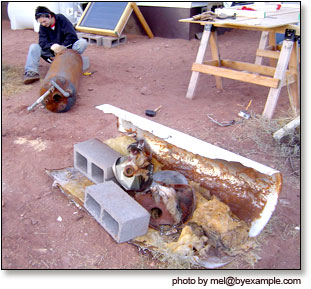
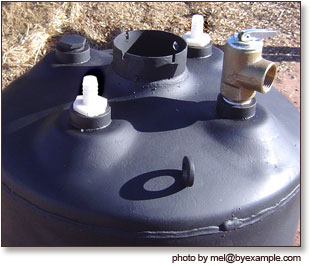
Once stripped and cleaned, the tank was thoroughly sanded and then spray painted black. We put several coats of spray paint on to give it maximum coverage. The spray paint was necessary to protect the metal tank from exposure to moisture and to increase the tank's absorption of heat. The appropriate fittings were then secured and extra holes plugged. There are 2 hose fittings, a pressure release valve, and a drain spigot.
Constructing and Insulating the Collector Box
After working on the tank, we built the collector box. Our measurements were calculated to accommodate the size of the glass, the size of our tank, and our desire for optimum solar exposure. Based on the sun's path we determined that the best angle for the glass to sit was 20˚. Once the frame was built, we affixed plywood paneling to the interior of the structure. Then all the interior seems were caulked and we primed and painted the wood.
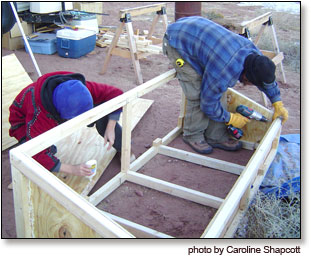

Next, recycled Styrofoam pieces were cut and wedged into the frame structure to serve as insulation. We also added an additional layer of cardboard beyond the Styrofoam to increase insulation even more. We save Styrofoam, packing peanuts, and bubble wrap to recycle as insulation - we love materials that you don't have to buy! We've also learned that insulation is key to maintaining heat.
After insulating, we painted the outer paneling and affixed it to the outside of the frame. The collector box is essentially a plywood box within a larger plywood box with a layer of Styrofoam as insulation in between.
Tank Supports and Glazing
Before installing the tank we cut 2x4s to match the tank's curve and firmly fastened them into the collector box. These supports were designed to hold the tank and to bear a considerable amount of weight. We used a recycled sliding glass door for the collector's glazing. Our glazing is single pane, however double paned glass is preferred for its superior insulating properties.
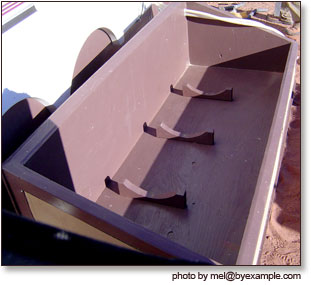
Installing the Tank
After the box was built and mostly painted we put the ready tank into place.
Then the water supply and return lines were attached from the house into the collector's storage tank. Cold water flows into the tank from the trailer's water system. Sun strikes the water storage tank and heats the water. The hot water floats to the top and the coldest water remains at the bottom of the tank. A hose leading from the top of the tank carries the hottest water into the house. Later an overflow hose was attached to the TPR valve to carry excess pressure out of the collector.
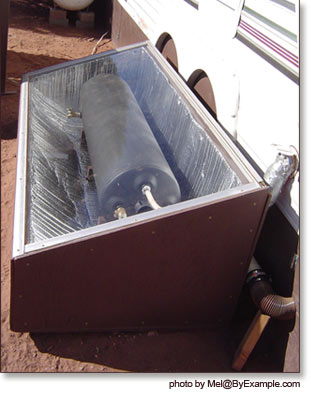
We lined the interior with reflectix insulation to direct maximum light towards the tank, and to further insulate the box. Because reflectix is reflective the sun is directed to strike the bottom and back of the tank, which would normally be in shadow. We also lined the top edge of the box with foam insulating tape before putting the glass in place.
With all the parts in place and Caroline long gone, we put the collector to the test. Our first full day of sunlight produced hot water and we were back in business. This very batch collector served us all winter and is still in operation. At night we took to covering the collector with a sleeping back to reduce heat loss, even so hot water was rare on winter mornings. With the majority of the pipes inside the collector, we had no more frozen or burst pipes. In the spring we encountered new and different challenges. With longer and more intense sun exposure our homemade hot water heater has become almost too efficient. Water is at scalding temperatures at the height of the day, and the CPVC hoses used for water intake and outlet have burst from heat and pressure! We have come to the conclusion that metal pipes will be necessary, as well as an anti-scald system.
All in all we are happy with the performance of this collector. I think it cost a little more than the first one, but it is much more efficient. I would recommend it as an excellent source of hot water, or as a supplement to conventional water heating systems.
That's not to say that hot water experiments don't have their challenges! Our homemade collector is under constant repair and revision.
Solar Hot Water Systems
To learn more about the wide variety of hot water heating systems view the following illustrations:
Unsupplemented Flat Panel Collector
Supplementing a Conventional Hot Water Heater
System with On-Demand Tankless Water Heater
Hot Water System with Heat Exchanger
Roof Mounted Tank and Collector
Attic Tank and Roof Top Collector
More DIY Solar Hot Water Projects
- DIY Flat Panel Solar Water Heater
- For information on how to build your own flat panel solar water collector read about our first solar hot water experiment. Flat panel water heaters work great in the summer...but ours couldn't take the freeze.
- Homemade Solar Shower
- After our batch water heater was complete we built an outdoor solar shower right next to the collector. We've posted a series of construction photos that show how we built our solar shower.
- Solar Hot Water Batch Collector Upgrade
- Since the initial construction of our solar hot water heating system we've made several adjustments to improve its functionality. Our greatest challenge has been designing the collector to work in the extreme temperatures of the desert climate.
Solar Water Heater Books
The following books offer more information on solar water heating systems. Plans for a variety of homemade solar water heaters are included in the book How to Build a Solar Hot Water System published by Sunny Future Press. My dad has a copy of How to Build a Solar Hot Water System and is currently using it in the construction of a roof-mounted, closed-loop, solar water heating panel.
To choose a greater selection of books visit the ByExample.com Bookstore. We offer a variety of how to books on topics related to off-grid living, homesteading and sustainability.
Tankless Water Heaters for Solar Hot Water Systems
Tankless water heaters are excellent for supplementing solar hot water systems and ensure hot water even on cloudy days. When hooked into a homemade solar water heating system, a tankless water heater will boost water (when necessary) to the ideal temperature before it's delivered to the faucet. Tankless water heaters use propane or natural gas to instantly heat water, but only do so when the hot water has been turned on in the house and only heat water that is about to be used. If the sun has sufficiently heated the solar water heater in a supplemented system, then the tankless water heater has no need to even turn on.

|
Even if you are not using a solar water heating system, a tankless water heater can help you to reduce your carbon footprint and take a stance against global warming. The smallest tankless water heater can be bought for $400 to $500, a modest investment when one considers the high environmental cost incurred by wasteful living. The Alternative Energy Store offers both propane and natural gas tankless water heaters in a variety of sizes. Click here to learn more about Tankless Water Heaters and "On-Demand" options. |
Not Ready to Build Your Solar Shower?Even if you are not ready to build your own solar shower, don't let that stop you from taking advantage of the sun's powerful energy. With a portable solar shower you can harness heat from the sun simply by placing it outside on a sunny day. A camp shower is an affordable and easy way to get solar hot water on the homestead, giving you time to design and build a permanent solar shower.
Don't wait to get started with solar! Click here |
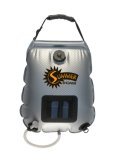 Advanced Elements 5 Gallon Solar Shower |